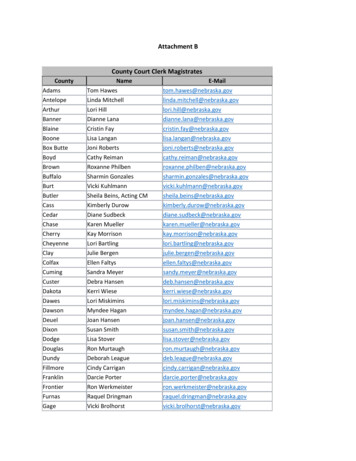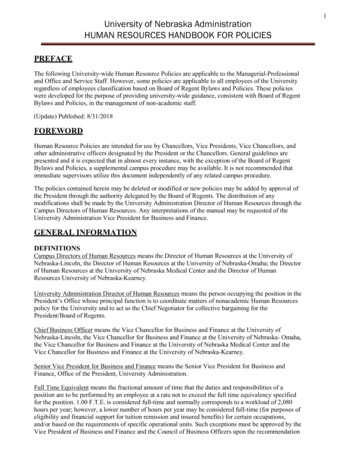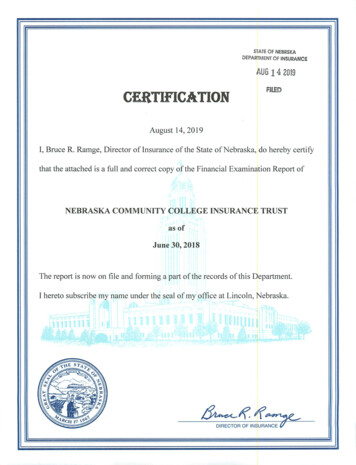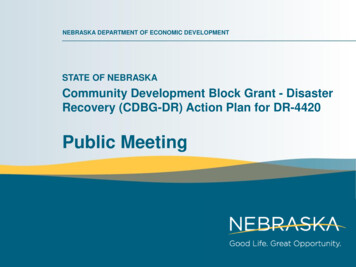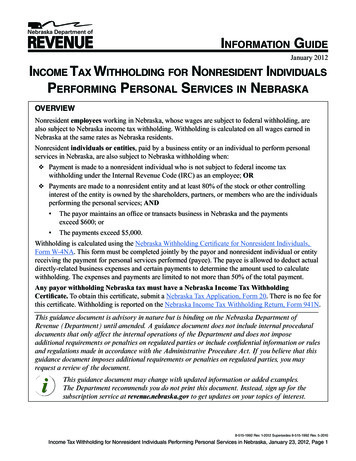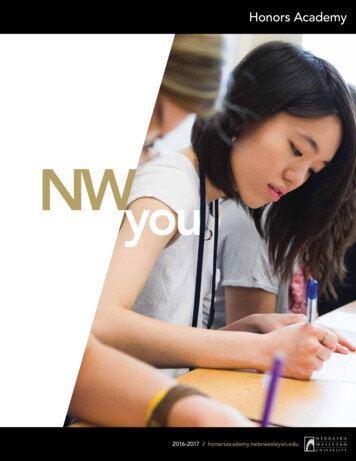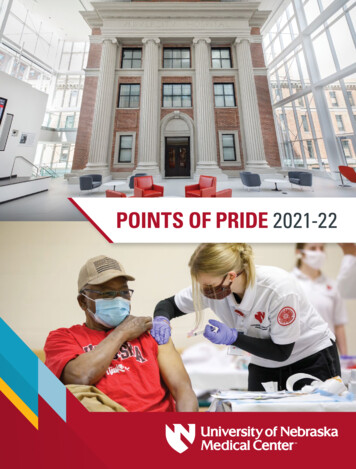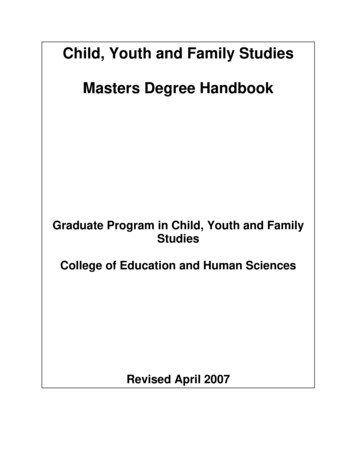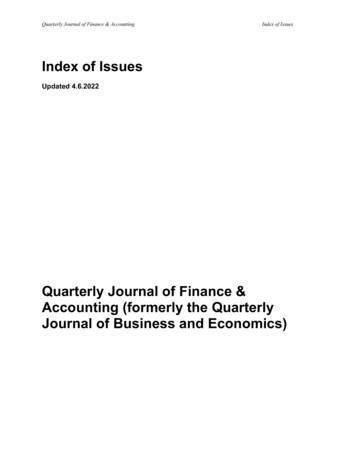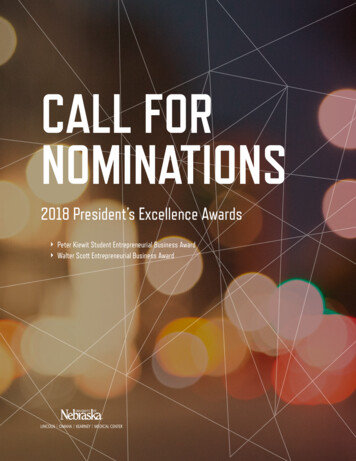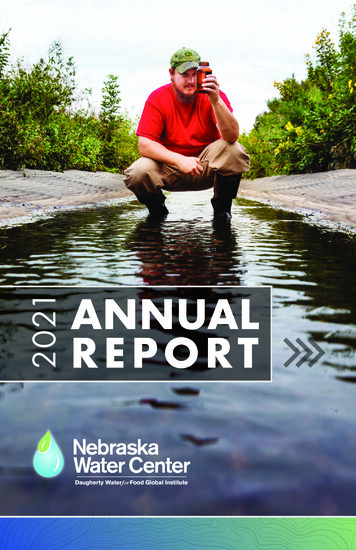
Transcription
2021ANNUALREPORT
2 OverviewThe Nebraska Water CenterThe Nebraska Water Center (NWC) was established by Congressional mandate asone of 54 state-based Water Resources Research Institutes in 1964. We coordinateresearch and programs that support the University of Nebraska as an internationalleader in water research, teaching, extension and outreach.Our fundamental goals are to:1 Coordinate a wide range of research impacting water issues2 Foster a deeper understanding of water and its many beneficial uses3 Help develop new water researchers4 Train future water researchers and engineers5 Extend research results to water professionals and the public throughpublications, seminars and conferences, electronic media, lectures and toursNWC is part of the Daugherty Water for Food Global Institute (DWFI) at theUniversity of Nebraska and part of the University of Nebraska–Lincoln’s Institute ofAgriculture and Natural Resources. Financial support for NWC and Water SciencesLaboratory comes from a combination of state, local and federal funding, as well asthrough partnerships with NGOs and industry.SNAPSHOTNWC 2021For more entInternsPostdoctoralResearchers95,700 in Grants toWater Facultyand Staff
Fast Facts wFacebookFollowsEventsHosted orCo-Hosted
WSL Research Lab Manager Victoria Dey prepares a sample in the lab.Water Sciences Lab UndergoesChallenges and Growth in 2021Like many research operations affected by the COVID-19 pandemic, 2021 was arebound year for the Water Sciences Laboratory (WSL). On the heels of a rocky2020 that saw sharp declines in the number of samples analyzed, the lab correctedcourse last year, running more samples by the year’s end than ever before.The lab managed this despite significant staffing changes. In July, WSL bid farewellto Laboratory Manager Saptashati (Tania) Biswas and after a competitive searchpromoted Victoria Dey into that role. To keep up with sample loads, the lab addedtemporary research technicians Gabriel Casper and Jean David Bizimana and aroster of undergraduate student interns. Finally, the lab’s visibility grew thanks tobusiness and marketing interns Callie Svoboda and Rachel Williss who promotedWSL through articles, videos, photos and events.The facility also had more to offer its community in 2021. A federal equipmentloan program allowed for the addition of a Thermo ICS 5000 Ion ChromatographySystem (ICS) and an Agilent 720 Inductively Coupled Plasma – Optical EmissionSpectroscopy (ICP-OES) system. The new ICS replaced an obsolete DionexICS-90, while the ICP-OES supplanted a labor-intensive atomic absorptionspectrophotometer. Both “new” instruments have been busy with increasingdemands for anions and metals analysis. Meanwhile, WSL debuted a new course inthe fall semester titled "Environmental Laboratory Instrumentation and Methods"to train students on lab equipment, procedures, housekeeping and safety.WSL also participated in several in-person and virtual events, including the inauguralEast Campus Discovery Days and Farmers Market, virtual educational events withConservation Nebraska and a mass spectrometry workshop series hosted by WatersCorporation. Plans are developing for an open house in 2022 to showcase newequipment, renovations and staff.A key part of NWC, the lab’s mission is to provide technology, expertise, services,and training in advanced analytical science supporting today’s water and naturalresources students, researchers and stakeholders.For more information4 Our Workwatercenter.unl.edu/water-sciences-laboratory2
NWC Director Chittaranjan Ray and NWC Assistant DirectorRachael Herpel attend a nitrate working group meeting.Nebraska Nitrate Working GroupsTackle Groundwater ContaminationBuilding on the previous year’s vision that “all Nebraskans will have access tosafe water,” NWC and University of Nebraska Extension convened working groupsthroughout 2021 to address the statewide challenge of rising levels of agrichemicalsin groundwater, particularly nitrates.To achieve this goal, three topics were prioritized for multi-sector collaboration:awareness, education and policy. A systems thinking approach with facilitatedideation was used to propose actionable projects that can be implemented inthree to five years and require cross-organizational support. In August, the workinggroups released a summary and call for action (go.unl.edu/nitrate-group).Each group then went on to begin implementing their proposals throughout thefall. Initial outcomes include a focus on nitrate at Husker Harvest Days; multipleinteractive training opportunities for growers to take fertilizer credits; continuedpolicy discussions; and a public awareness campaign design workshop. These effortshave already impacted hundreds of citizens across Nebraska.Throughout the year, 115 participants from 36 organizations were working togethertowards this vision for Nebraska. NWC will continue to lead this multi-sectorcollaboration as further projects are implemented in 2022.Our Work 5
A trio of senior design students at work on the Nebraska Vadose Zone project.NWC and Computer Science Students Dive IntoNebraska’s GroundwaterWhat’s the vadose zone? That’s the common response when anyone is askedabout this feature of the earth. Indeed, it was the response a group of University ofNebraska–Lincoln (UNL) computer science students first had. Today, those studentsare part of the School of Computing’s Senior Design capstone program, whereindustry and academic sponsors work with talented undergraduates who createprofessional-grade software, hardware and IoT applications.By partnering with NWC on their senior design project, these students learnedhow the vadose zone acts as the earth’s skin, regulating the storage, transportand transformation of agrichemicals between the crop root zone and water table.What happens to chemicals in this zone can impact the quality of Nebraska’s mostabundant yet precious natural resource — groundwater. With greater understandingof this zone, water managers can better predict groundwater contamination andhow to implement interventions at the source.This year, the students worked on revamping the Nebraska Vadose Zone website.The centerpiece is an interactive map where data on agrichemicals (like nitrate)is collected, processed, analyzed and shared for the general public. The group isincreasing the site’s user experience; enabling data uploading and verification; andsharing results through interactive mapping.Working on the project revealed important connections between food and theenvironment. “You don’t think about the fertilizer applications to grow your food.This is a nice window into what you don’t see every day," said senior Cody Binder.Will Swiston noted the geographic disconnect he felt as a native Chicagoan. “I hadno idea about fertilizer getting into the water table,” he said. “I learned a lot aboutthe science from this project.”Senior Design Project Manager Bill Browning is interested in a different type ofchemistry. “I’m always impressed by how five students who don't know each othercome together to work for a common goal.”For more information6 Our Worknebraskavadose.unl.edu
The Austin Sailors Quintet serenades the evening banquet at the Legacy of the Plains Museum.NWC Heads West for Annual Conference,Online for Spring SeminarsNWC trekked across the state to host its annual Nebraska Water Conference in2021. Titled “The Shape of Water in Western Nebraska,” the conference washeld August 16 at UNL's Panhandle Research and Extension Center inScottsbluff, Nebraska.The daylong event attracted 90 participants and featured western Nebraska waterleaders discussing water infrastructure in the panhandle; western Nebraska’sunique hydrogeology; and cutting-edge research in water and agriculturalmanagement. Attendees also enjoyed live jazz at an evening banquet at theLegacy of the Plains Museum with the Scotts Bluff National Monument as acharismatic backdrop.August 17 and 18, NWC also participated in a post-conference water tour sponsoredby the Scottsbluff/Gering United Chamber of Commerce. Approximately 50participants traversed the North Platte River basin, making educational stops atfisheries, dams, ranches, potato processors and Lake McConaughy.Due to the pandemic, NWC hosted its 2021 Spring Seminar Series virtually. Theseries, “Tributaries: Race, Justice and the Environment,” knit social justice andwater issues together through speakers representing engineering, water chemistry,environmental studies, legal, public policy and tribal backgrounds.Established in 1968, the series provides a forum to increase awareness and allow formeaningful conversation regarding water issues.For more on the Nebraska Water ntsFor more on the Spring Seminar Serieswatercenter.unl.edu/spring-seminar-seriesOur Work 7
Troy Gilmore, a UNL groundwater hydrologist and DWFI Faculty Fellow,was one of several USGS 104b recipients.USGS Small Grants Support Big Ideas in WaterNWC awarded U.S. Geological Survey (USGS) 104b project funds to six Nebraskaresearch teams in 2021:1 Examining Surface and Groundwater Contamination from Use of ByproductsDerived from Ethanol Processing of Pesticide-Treated Crop Seeds and thePotential Impacts on Biological Indicator Organisms; PI: Judy Wu-Smart, UNL,Department of Entomology; Co-PIs: Shannon Bartelt-Hunt, Department of CivilEngineering; Dan Snow, Nebraska Water Center; 20,0002 Advancing Groundwater/Surface Water Models using Geophysics-DerivedHydrostratigraphy; PI: Jesse Korus, UNL, School of Natural Resources; Co-PI:Sorab Panday, Biological Systems Engineering; 20,0003 A Data-Led Approach to Visualizing and Assessing Nitrate Contaminationin Northeastern Nebraska; PI: Erin Haacker, UNL, Earth and AtmosphericSciences; Co-PI: Sorab Panday, Biological Systems Engineering; 19,0004 Image-Based Streamflow and Water Quality Modeling; PI: Troy Gilmore, UNL,School of Natural Resources; Co-PIs: Michael Forsberg, School of NaturalResources; Andrew Harms, Electrical and Computer Engineering; Mary Harner,UNK, Biology; 11,6555 Evaluation of Nitrogen-based Redox Processes in the Vadose Zone; PI: MichaelKaiser, UNL, Department of Agronomy and Horticulture; Co-PIs: Dan Snow andArindam Malakar, Nebraska Water Center; Daniel Miller, USDA-ARS; MatteoD’Alessio, University of Mississippi, Civil Engineering; 9,9826 Know Your Well – Northwest; PI: Michael Leite, Chadron State College,Mathematical and Natural Sciences; Co-PIs: Tawny Tibbits, Chadron StateCollege, Mathematical and Natural Sciences; Dan Snow, Nebraska WaterCenter; 3,1208 Our Work
Installing lysimeters at the BGMA soil health demo site.Partnering for a Clean Water Futurein Northeast NebraskaNortheast Nebraska is unique in many ways. One of those is the first groundwaterfocused management plan in the nation to address nonpoint source pollution.The Bazile Groundwater Management Area (BGMA), as it’s known, emerged froma partnership among four area Natural Resources Districts and the NebraskaDepartment of Environment and Energy who shared the goal of reducing risingnitrate levels in communities and domestic drinking wells. This is significant sinceBGMA residents rely on groundwater for drinking water and elevated nitrate levelscan be harmful to human health and costly for small communities to treat.In 2019, NWC, through funding from the Nebraska Environmental Trust, helpedestablish local demonstration farms that model different agricultural managementpractices to reduce nitrogen leaching. The three farms — diverse cropping rotations,soil health and nitrogen inhibitors — provided opportunities for educationaloutreach at the BGMA Field Day in September 2021. The in-person engagementwas complemented by a virtual winter meeting series featuring Nebraska faculty,postdocs and external scholars.Additionally, NWC is invigorating water quality research and education in this area.In the classroom, a citizen science project is empowering high school students withwater quality awareness and science literacy through groundwater sampling anddata collection. In the field, WSL Director Dr. Dan Snow and collaborators launcheda project in spring 2021 titled “Novel Approaches for Controlling Nitrate Leachingand Protecting Nebraska Groundwater.” The research is injecting mulch into thesubsoil to evaluate its potential to absorb and remove excess nitrate.For more informationbgma.nebraska.gov/Our Work 9
A UNL research team collects soil samples near Mead, Nebraska, in November 2021.Research Monitors Impacts ofAltEn Pesticide ContaminationWith essential support from the NWC, a multi-university team is monitoring oneof Nebraska’s worst environmental disasters. In 2021, the University of NebraskaMedical Center and Creighton University partnered with UNL and NWC to explore thescope of contamination stemming from the AltEn ethanol plant near Mead, Nebraska.When the plant opened in 2015, it represented an innovative way to generateethanol from feedstocks consisting almost entirely of leftover seed corn treated withpesticides and fungicides. Treated seed is not unusual; but using it in large volumesto produce ethanol is. Over time, area residents became concerned as fish, bees andhouse pets fell ill or died. Residents reported strong odors in the air, burning eyes andbreathing difficulties. In early 2021, the State of Nebraska shut down the plant afternumerous violations and a burst pipe spilled waste into a nearby watershed.The human health impacts are unknown. Measuring the extent of contaminationwithin the surrounding land, air, water and animals is the first step and whereNWC enters. WSL, part of NWC, is the primary destination for all water and soilsamples collected through this research. A committed group of students and fulltime technicians operate its high-precision equipment using sophisticated methods.Additionally, NWC awarded a USGS 104b grant (p.8) to an entomologist studying theimpact on pollinators.According to Shahab Karimifard, a UNL postdoctoral researcher collecting theproject’s data, the team will continue to monitor all aspects of the environmentaffected and have more decisive results in the near future.What emerges from this collaborative investigation will help answer critical questions– for both the people of Mead and future communities exposed to pesticidecontamination. What’s in our water? What does this mean for our health?For more information about Nebraska’s AltEn research10 Our Workgo.unl.edu/mead
Our ImpactNWC was established by an act of Congress in 1964. Part of the Daugherty Waterfor Food Global Institute, we coordinate research and programs that support theUniversity of Nebraska as an international leader in water research, teaching,extension and outreach.Learn morewatercenter.unl.eduNebraska Water Center 11
eduThe University of Nebraska does not discriminate based upon any protected status. Please seenebraska.edu/nondiscrimination. 2022 The University of Nebraska Board of Regents. All rights reserved.
University of Nebraska and part of the University of Nebraska-Lincoln's Institute of . Agriculture and Natural Resources. Financial support for NWC and Water Sciences . Laboratory comes from a combination of state, local and federal funding, as well as through partnerships with NGOs and industry. For more information . watercenter.unl.edu
